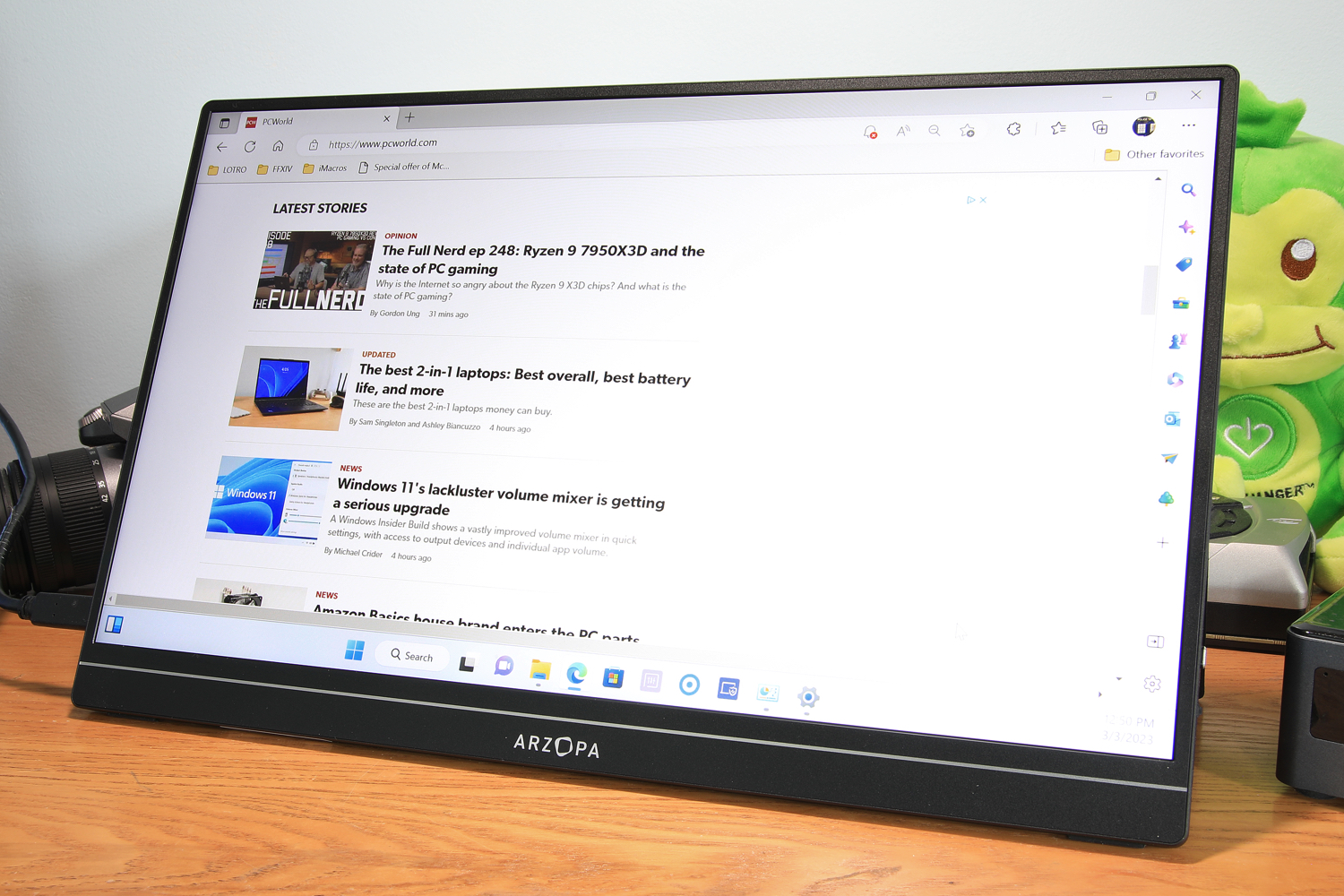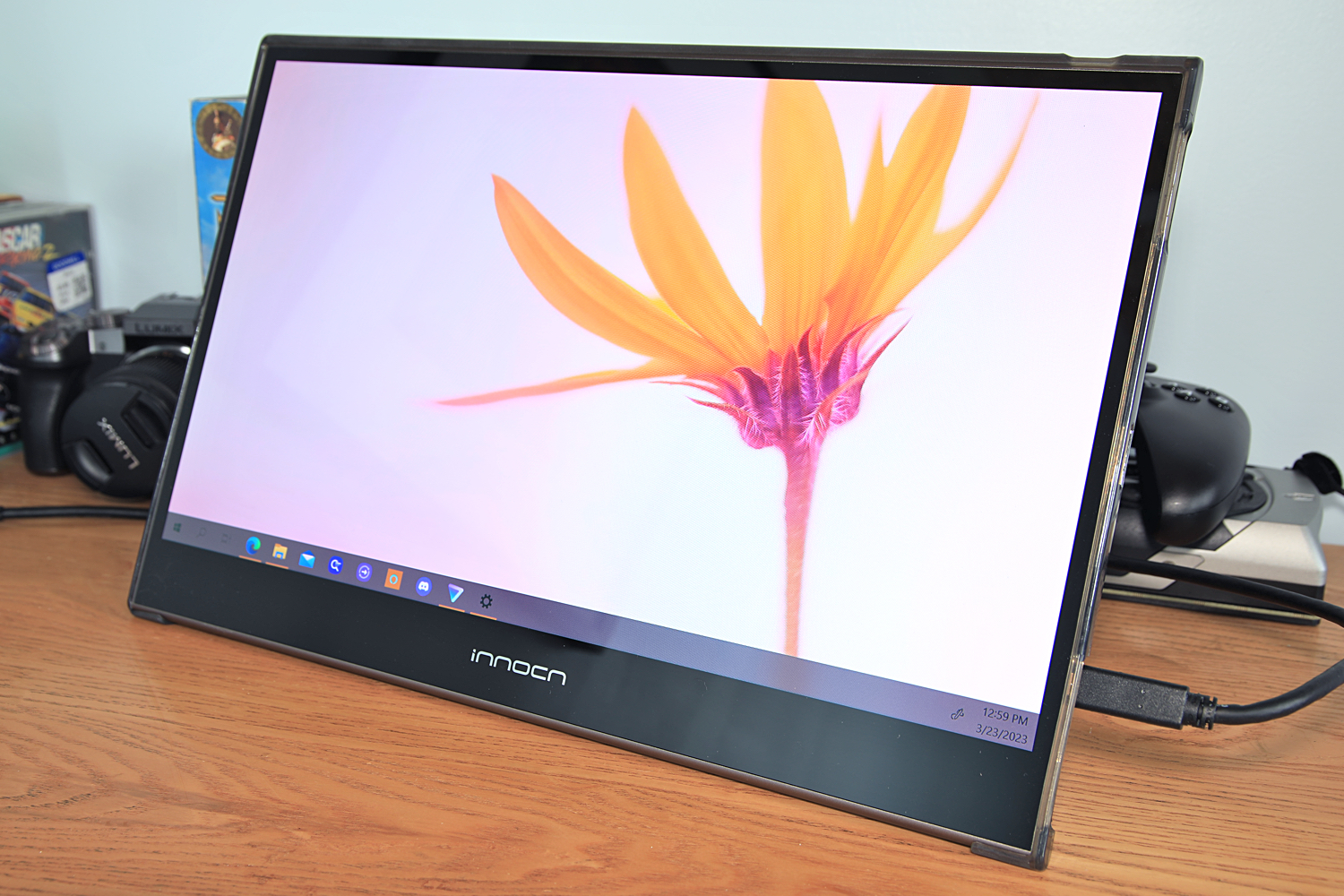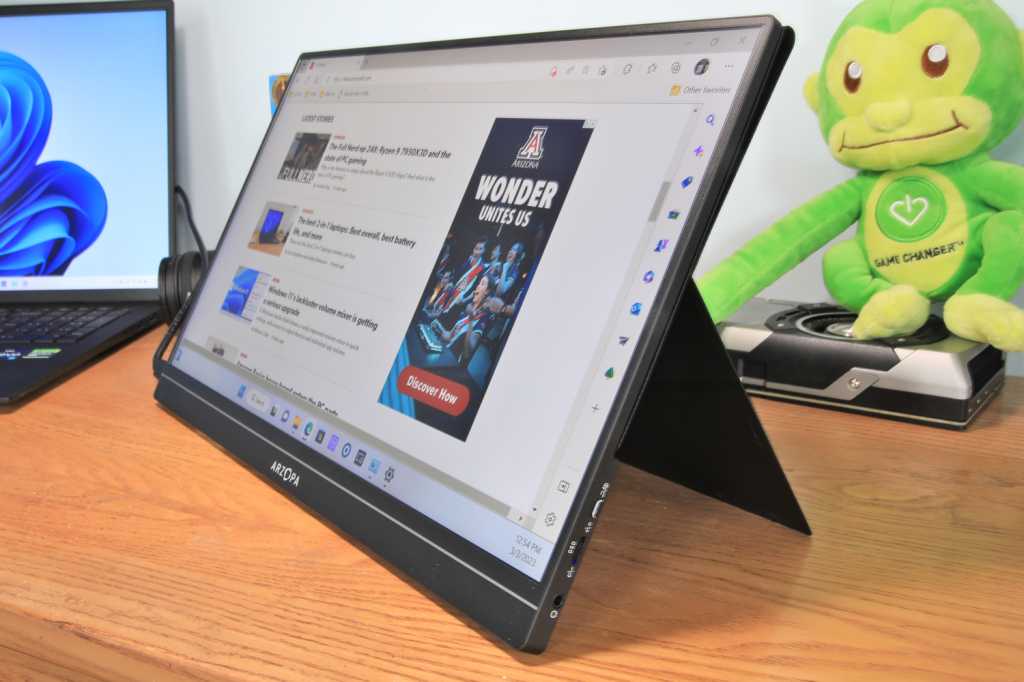Portable monitors are a common sight on many desktops, and even more laptops. Though smaller than a standard monitor, portable monitors are inexpensive, easy to connect and, best of all, portable. You can pack up and move a portable monitor when needed, a perk that’s equally useful for students, work-from-home parents, and globe-trotting executives.
There’s just one problem: The portable monitor market is a bit of a mess. The widespread availability of small displays has opened the floodgates for numerous brands you’ve never heard of, and quality is often sub-par. We’ve tested multiple models to separate the best portable monitors from the rest.
Further reading: See our roundups of the best monitors and best home office monitors for even more recommendations.
Viewsonic ColorPro VP16-OLED – Best portable monitor overall
Pros
- Versatile, useful stands
- Good connectivity, cables included
- Numerous image quality customization options
- Top-tier image quality even at default settings
Cons
- Speakers are included, but weak
- Pricey for a portable monitor
- No HDR
Price When Reviewed:
$399.99
Viewsonic’s ColorPro VP16-OLED is a portable monitor that targets professionals and enthusiasts. It has class-leading image quality and a unique, versatile stand.
The 15.6-inch 1080p OLED panel delivers a brightness of 375 nits and an impressive color gamut that spans the entire sRGB and DCI-P3 color gamut. Although it lacks HDR support, it compensates with class-leading contrast, outstanding color accuracy, and numerous image quality options that will help you adjust the display to fit your needs.
You’ll enjoy the unique attached stand that can be used as a kickstand or raised to provide a more comfortable viewing angle. It’s the only portable monitor on the market with this feature. It adds weight, however: at 4.8 pounds, the VP16-OLED is heavier than most portable monitors.
Viewsonic tosses in several features that make the VP16-OLED ideal for professional content creators. It ships with a bundled hood that can be used to reduce glare in a bright environment. The monitor can also mount a standard tripod screw mount for use on-the-go in a studio or outdoors.
Priced at $399.99, the VP16-OLED is more expensive than most competitors. Still, the price is more than justified by the monitor’s performance. Most portable monitors will feel out of date within a few years, but this display will remain a top performer for years to come.
Read our full
Viewsonic ColorPro VP16-OLED review
Arzopa A1 Gamut – Best budget portable monitor

Pros
- Good build quality for the price
- Bright, attractive display
- Two USB-C inputs, plus mini-HDMI
- All cables included
Cons
- Stand only adjusts for tilt
- Limited image quality adjustments
- Mediocre contrast ratio
Price When Reviewed:
$189.99
The Arzopa A1 Gamut is a solid 15.6-inch 1080p portable monitor that delivers good image quality, an attractive design, and useful features at a low price.
Arzopa opts for a simple yet elegant design that pairs a thin display panel with a small bump on the lower half to house the monitor’s ports and internal electronics. A faux-leather cover is included to provide protection when stowed. It also folds into a kickstand when the monitor is in use.
The monitor has three input options: two USB-C with DisplayPort Alternate Mode and one Mini-HDMI. All required cables and accessories are included. However, the monitor’s menu system is hard to use and offers few adjustments.
Image quality is great for the price. The Azorpa A1 Gamut reaches a maximum brightness of 297 nits, which is brighter than many competitors. The color gamut spans 97 percent of sRGB and 74 percent of DCI-P3. The A1 Gamut appears bright and vivid in day-to-day use and, though not ideal for professional content creation, holds up well while browsing the web, working in Microsoft Office, or viewing YouTube.
The Arzopa A1 Gamut retails for $170 but is frequently sold at a steep discount, often as low as $110. It’s an absolute steal when on sale, and we highly recommend waiting for a discount if one isn’t currently available.
Innocn 15K1F – Best budget OLED portable monitor

Pros
- Excellent build quality
- Good brightness, great contrast ratio
- Wide color gamut
Cons
- Case and kickstand feel flimsy
- Display is extremely reflective
- Mediocre sharpness
Price When Reviewed:
$269.99
Want a portable monitor with premium image quality at a midrange price? The Innocn K151F should be on your short list.
The Innocn 15K1F is a 15.6-inch 1080p OLED portable monitor priced at $269.99, providing a less expensive alternative to the Viewsonic ColorPro VP16-OLED. The 15K1F has an outstanding contrast ratio, a color gamut that spans 100 percent of sRGB and 99 percent DCI-P3, and good out-of-box color accuracy. The VP16-OLED is better, but the more affordable Innocn K151F nips at its heels.
Innocn’s design feels robust and looks attractive. Connectivity is strong, too, with a pair of USB-C ports and one Mini-HDMI port, offering a variety of options and the ability to connect multiple input devise. The menu system is competitive with the VP16-OLED and offers customization for color temperature, saturation, hue, and three-axis RGB color calibration.
Unfortunately, the included cover and kickstand could be improved. The cover physically snaps over the display and does not use magnets, which makes it a bit difficult to install or remove. The kickstand can easily slip out of place if you accidentally bump the monitor. It’s usable but a clear step down from the kickstands available on more expensive competitors.
Still, it’s hard to argue with the image quality Innocn offers for $270. It performs almost identically to the more expensive Viewsonic VP16-OLED. Innocn’s cover and kickstand falls short, but we suspect many people would rather pocket the savings and buy their own third-party stand.
Read our full
Innocn 15K1F review
What to look for in a portable monitor
Many of the features we look for in a desktop monitor also apply to a portable monitor. A portable monitor should have a bright, sharp image with a decent contrast ratio, wide color gamut, and great color accuracy. The differences between portable monitors and their desktop brethren are more often found in their design, build quality, and connectivity.
Image quality
Most portable monitors have image quality similar to desktop monitors in the same price bracket. Portable monitors tend to score well in brightness and sharpness, but color and contrast are often lacking. OLED portable monitors perform significantly better than less expensive IPS LCD displays. Unfortunately, they’re much more expensive.
Numerous small brands have jumped into the portable monitor market in recent years and quality control can be an issue. We recommend sticking to monitors that are known to achieve high marks in image quality (otherwise, be prepared to use a retailer’s return policy).
Stands, kickstands, and covers
Portable monitors ship with a bundled kickstand or stand that is used to keep the monitor propped up and steady on a desk.
Unlike desktop monitors, where most stands are more or less identical, the stands used by portable monitors vary. Some have a simple kickstand that attaches magnetically, while others use a clip-on case. A rare few, like the ViewSonic ColorPro VP16-OLED, have a folding stand that provides significant height and kickstand adjustment.
Connectivity
Connectivity is key. A portable monitor that lacks the port you need to connect your tablet or laptop is useless.
Most portable monitors offer the option to connect over USB, a video input (usually HDMI), or both, but the number of ports available and the standards used vary widely. We look for monitors that offer a healthy selection of ports. We also prefer monitors that can be powered over USB-C by a connected desktop or laptop.
Portability, size, and weight
Our final consideration is the most obvious: portability. Most portable monitors live up to their name with an included kickstand case or cover that can fold flat and protect the display while it’s stowed.
Still, the exact size and weight of a portable monitor is important, and shoppers may need to accept trade-offs between weight and quality. A top-notch pick like the Viewsonic ColorPro VP16-OLED can offer superior durability, but a lightweight budget pick like the Azorpa A1 Gamut might be preferable if you’ll be hauling a portable monitor daily.
How we test monitors
PCWorld’s monitor evaluations stem from the expertise of freelance and staff contributors with decades of collective experience. Although our initial impressions rely on our eyes, we rigorously test each monitor using a SpyderXElite color calibration tool for a comprehensive analysis.
This device helps us objectively measure a variety of monitor attributes including brightness, contrast, color gamut, color accuracy, luminance and color uniformity, and gamma, among other traits.
We also rely on hands-on testing to judge the quality, size, and weight of a portable monitor. Every monitor we recommend is personally tested first-hand by a PCWorld contributor. This helps us pick out flaws in build quality and portability that separate the best and worst portable monitors.

